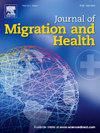Prevalence of peripheral neuropathy, diabetic foot and level of glycemic control in refugees and migrants residing in Greece
IF 2.9
Q1 PUBLIC, ENVIRONMENTAL & OCCUPATIONAL HEALTH
引用次数: 0
Abstract
Introduction
Data regarding access to diabetic neuropathy (DN) and diabetic foot (DF) examination, as well as the prevalence of these conditions in refugees and migrants (R&M) with diabetes mellitus (DM) residing in European countries are currently lacking. The study’s primary objective was the estimation of DN and DF prevalence among diabetic R&M residing in Greece. Associations between DN diagnosis, demographic characteristics, glycemic control (HbA1c value), housing status and level of access to the National Healthcare System (ESY) were secondarily explored.
Materials and methods
R&M with DM were screened for DN/DF at the Doctors of the World’s central polyclinic in Athens. For DN diagnosis, calculation of the Neuropathy Disability and Neuropathy Symptoms scores for each patient was followed by examination with 10 g Semmes-Weinstein monofilament. Demographic characteristics were also collected. Logistic regression was used for DN correlation with various variables. For HbA1c value association with the variables “Social Security Number (AMKA) possession” (representing access to ESY) and "unstable housing", Shapiro-Wilk regularity and Mann-Whitney tests were used. P < 0.05 was selected as the cutoff for statistical significance.
Results
From 67 patients examined, 47.8 % (n = 32) and 7.5 % (n = 5) were diagnosed with DN and DF respectively, while none had been previously screened for DN in Greece. In the single-factor analysis, age, years of diabetes and AMKA were significantly associated with DN. In the multivariate analysis, only age remained statistically significant. A statistically significant decrease in HbA1c values was observed in AMKA holders. Lower HbA1c values were observed in those with stable housing, but the association was not statistically significant.
Conclusion
A significant percentage of our study participants were diagnosed with DN and DF. Significantly lower HbA1c values were observed in patients with AMKA, thus underlining the importance of improving access to healthcare services for marginalized populations in Greece.
希腊难民和移民周围神经病变、糖尿病足和血糖控制水平的患病率
目前缺乏关于糖尿病神经病变(DN)和糖尿病足(DF)检查的数据,以及居住在欧洲国家的患有糖尿病(DM)的难民和移民(R&;M)中这些疾病的患病率。该研究的主要目的是估计居住在希腊的糖尿病R&;M中DN和DF的患病率。其次探讨DN诊断、人口统计学特征、血糖控制(HbA1c值)、住房状况和国家医疗保健系统(ESY)可及程度之间的关系。材料和方法在雅典世界医生中心综合诊所对DM患者进行DN/DF筛查。对于DN的诊断,计算每位患者的神经病变残疾和神经病变症状评分,然后用10 g Semmes-Weinstein单丝检查。还收集了人口统计学特征。采用Logistic回归对DN与各变量的相关性进行分析。对于HbA1c值与“社会安全号码(AMKA)持有”(代表获得ESY)和“不稳定住房”变量的关联,采用Shapiro-Wilk规则和Mann-Whitney检验。P & lt;统计学意义以0.05为截止值。结果在67例患者中,分别有47.8% (n = 32)和7.5% (n = 5)被诊断为DN和DF,而此前在希腊没有人接受过DN筛查。在单因素分析中,年龄、糖尿病年数和AMKA与DN显著相关。在多变量分析中,只有年龄仍然具有统计学意义。在AMKA持有者中观察到HbA1c值有统计学意义上的显著下降。稳定住房组的HbA1c值较低,但相关性无统计学意义。结论我们的研究参与者中有相当比例的人被诊断为DN和DF。在AMKA患者中观察到明显较低的HbA1c值,从而强调了改善希腊边缘化人群获得医疗服务的重要性。
本文章由计算机程序翻译,如有差异,请以英文原文为准。
求助全文
约1分钟内获得全文
求助全文
来源期刊

Journal of Migration and Health
Social Sciences-Sociology and Political Science
CiteScore
5.70
自引率
8.70%
发文量
65
审稿时长
153 days
 求助内容:
求助内容: 应助结果提醒方式:
应助结果提醒方式:


